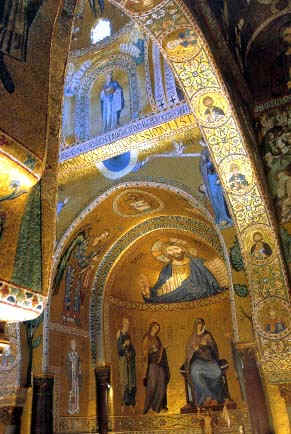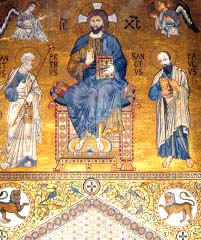Thus
commented Augusto Schneegans at the night of this incomparable monument.
Its structure and the interior decorations represent the artistic fusion
of the three components – Siculo-Roman, Byzantine and Arab – which
have created immortal architectural masterpieces in Sicily. The interior
combines the longitudinal plan of a Roman basilica with a central
Byzantine body, creating a harmonius conjunction of lines and volumes.
It extends over 32 metres lengthwise, with a nave and two aisles divided
by two lines of five alternating Egyptian marble and half-fluted cipolin
columns with Corinthian or composite capitals, one which is Arab. The
Chapel is 12.5 m wide and 12.4 m high (18 m in the dome). The wooden
lacunar of the nave was executed by Muslim craftsmen and is decorated
with figures and inscriptions in Cufic characters. Mosaic entirely cover
the walls of the nave, aisles and sanctuary, in a glittering gilded
phantasmagoria of biblical scenes, saints and stories from the life of
Christ.
|
|
| Mosaic
representation of Christ Pantocrator blessing in the central
apse. In his left hand, Jesus is holding the Gospel; the Greek
and Latin inscription reads: “I am the light of the world.
Whoever follows me will never walk in darkness, but will have
the light of life”. |
|
|
| Christ
blessing overhanging the royal throne on the back wall. Jesus is
sitting on the throne and is flanked by the Apostles Peter and
Paul; above them, the Archangels Gabriel and Michael. The two
lions at the sides of the throne are a symbol of power and
sovereignty. |

